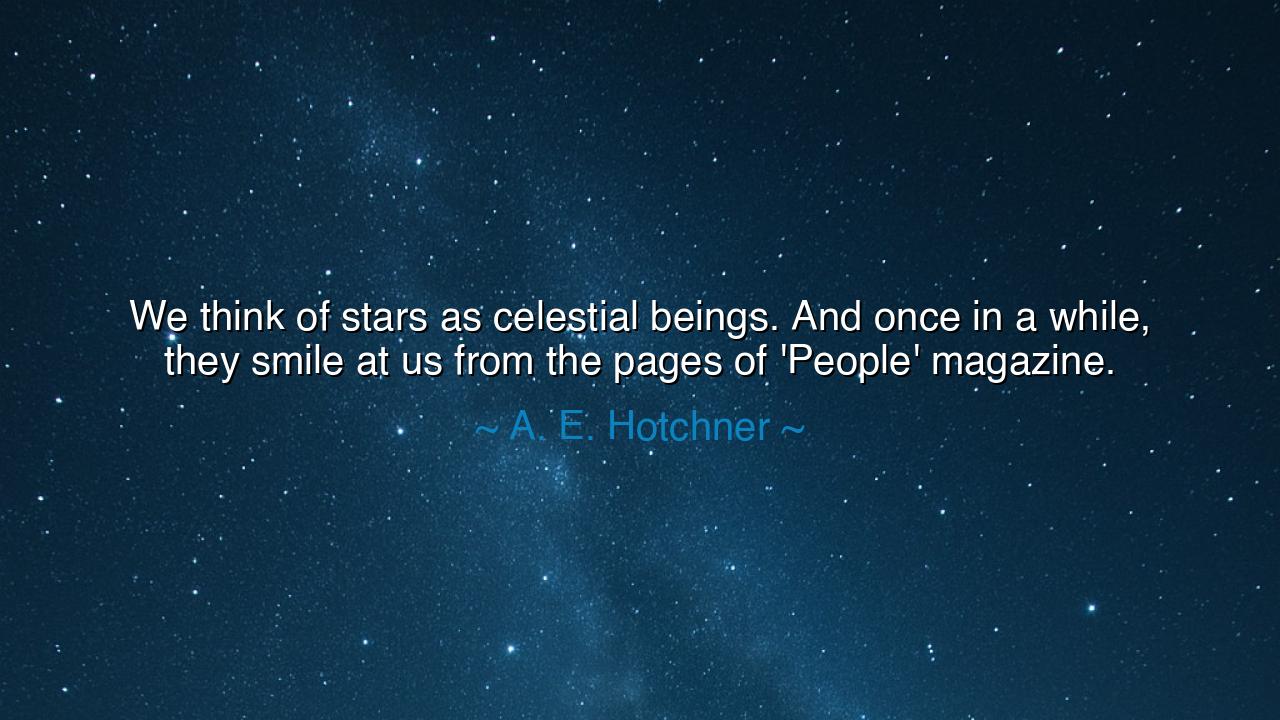
We think of stars as celestial beings. And once in a while, they
We think of stars as celestial beings. And once in a while, they smile at us from the pages of 'People' magazine.






The words of A. E. Hotchner shimmer with irony and truth: “We think of stars as celestial beings. And once in a while, they smile at us from the pages of People magazine.” Here he speaks not only of the distant fires that light the heavens, but of the mortals whom society crowns as luminous, those whose beauty, talent, or fame cause us to look upon them as though they were otherworldly. Yet he also reminds us that such stars, for all their elevation, descend into our reach not in divine visions but in the ordinary gloss of a magazine page.
To call someone a star is an ancient impulse. From the earliest ages, humanity looked to the night sky and saw in its constellations the shapes of heroes and gods. Orion was the mighty hunter, Cassiopeia the vain queen, Hercules the strong. The heavens were a mirror of greatness, and the shining lights above became symbols of destiny and immortality. In our age, the metaphor has shifted from the firmament to the stage and screen, but the impulse is the same: to raise certain figures above the multitude, to see them as beyond human, as celestial beings.
Yet Hotchner’s words cut through the illusion. He reminds us that the modern star does not dwell in untouchable eternity but smiles at us from the fleeting surface of a magazine, their divine image captured, commodified, and circulated for our consumption. The very act of seeing them in People is a kind of fall from Olympus—they are at once glorified and reduced, adored and objectified, heavenly yet profoundly ordinary. The paradox is striking: we elevate them to celestial heights, yet we meet them in the most mundane form, leafed between recipes, advertisements, and gossip.
History offers its parallels. In ancient Rome, gladiators and actors were adored as living stars, their names shouted by crowds, their images etched into pottery and plastered on walls. Yet these same men and women, worshipped in arenas, were also slaves or outcasts in society. They were glorified and diminished at once, their greatness dependent on the whims of the people. Just as today we see a famous actor’s smile in a glossy spread, the Romans once carried painted tiles of their favorites, both idolizing and trivializing them. The pattern is eternal: humanity exalts, yet also consumes, its chosen figures.
The lesson is this: be wary of worshiping mere images. To mistake the smile in a photograph for the true soul behind it is to grasp at shadows. The star, like the heavenly body, may shine brightly, but even the brightest star is made of the same matter as all creation—fire, dust, and gravity. So too are our human stars of flesh and bone, with hopes, fears, and flaws. To revere them as gods is folly; to recognize them as fellow travelers on life’s road is wisdom.
Yet Hotchner does not entirely condemn. There is sweetness in the fact that we long for smiles, that we wish to see light in another’s face, even if it comes through the strange medium of celebrity culture. It reveals our hunger for beauty, for inspiration, for beings who can seem larger than ourselves. This longing is not wrong, but it must be tempered with truth: admiration should inspire us to grow, not enslave us to illusion.
Therefore, let us take this teaching into our lives. Admire those who shine, but do not forget their humanity. Seek stars, not in the fleeting pages of magazines alone, but in the small acts of courage and kindness around you. The teacher who lights the mind, the nurse who eases pain, the parent who sacrifices daily—these are true celestial beings, though their smiles are not printed in glossy spreads. Learn to see them, and you will never lack for inspiration.
Thus, the words of Hotchner are not mere wit, but a parable. He shows us that humanity’s love of stars is eternal, yet also fragile. We must look beyond the glittering image, past the glossy smile, and see the soul beneath. And if we can do this, we will learn not only how to honor those who inspire us, but also how to find the celestial in ourselves.






AAdministratorAdministrator
Welcome, honored guests. Please leave a comment, we will respond soon